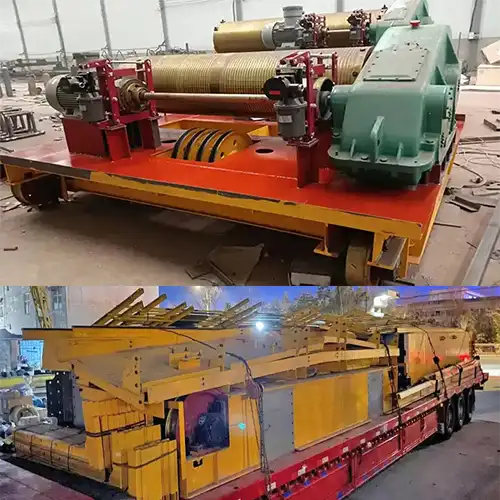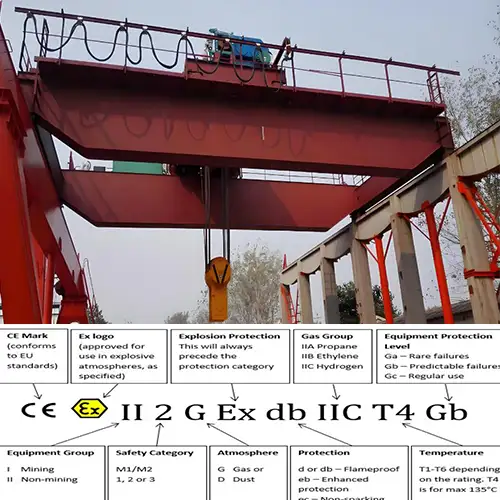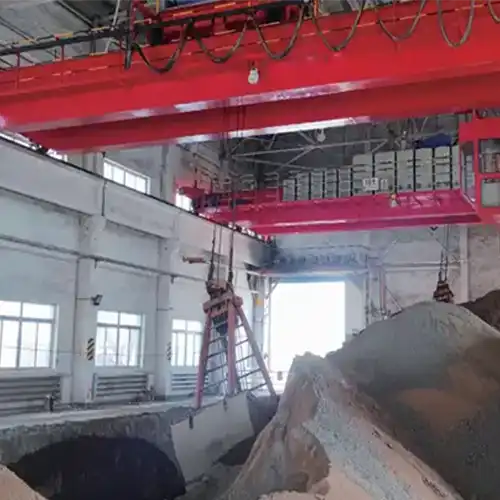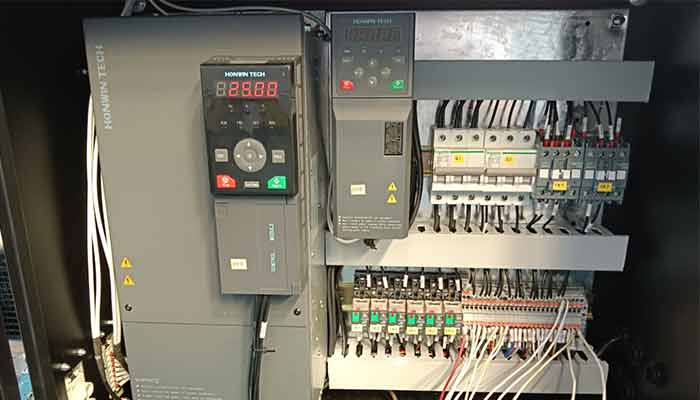
Variable Frequency Drives (VFDs) Control Single Girder Gantry Crane
The Role of Variable Frequency Drives (VFDs) in Single Girder Gantry Crane Control
In the world of material handling, precision and efficiency are paramount. This is particularly true for single girder gantry cranes, versatile workhorses that play a crucial role in various industries. But what if we told you there's a technology that can enhance control, improve efficiency, and even save energy in the operation of these cranes? That's where Variable Frequency Drives (VFDs) come into play.
Importance of Control and Efficiency in Single Girder Gantry Crane Operations
Single girder gantry cranes are indispensable tools for lifting and moving heavy loads within warehouses, factories, and construction sites. They are designed to offer the precision required for safely and efficiently transporting materials. To achieve this precision, control is key.
Control allows operators to perform tasks such as positioning loads with accuracy and smoothly transitioning from one operation to the next. However, achieving this level of control can be a complex task, especially when handling substantial weights.
Furthermore, in today's environmentally conscious world, efficiency is not just a buzzword but a necessity. Efficient material handling not only saves time and money but also reduces energy consumption and environmental impact. Therefore, the search for ways to make single girder gantry crane operations more efficient and eco-friendly has led to the adoption of VFDs.
In this series, we'll dive deep into the role of Variable Frequency Drives (VFDs) in the control of single girder gantry cranes. We'll explore how these devices work, their benefits in enhancing control, and the energy savings they bring to crane operations. Let's unlock the potential of VFDs in material handling, making crane operations more precise, efficient, and environmentally responsible.
Join us in the following parts of this series as we delve into the world of VFDs, how they work, and the incredible impact they have on single girder gantry crane operations.
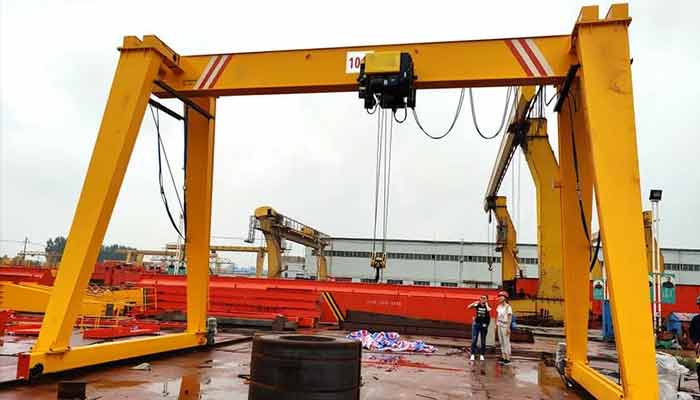 VFD control gantry crane with single girder design
VFD control gantry crane with single girder design
Understanding Variable Frequency Drives (VFDs)
To appreciate the significance of Variable Frequency Drives (VFDs) in single girder gantry crane control, it's crucial to understand what VFDs are and how they function. In this part of our series, we'll explore the fundamentals of VFDs, their operation, and their pivotal role in controlling the speed and torque of electric motors.
Explanation of What VFDs Are
Variable Frequency Drives, commonly known as VFDs or inverters, are sophisticated electronic devices that control the speed, torque, and direction of electric motors. These devices have become an integral part of modern industrial machinery, including single girder gantry cranes.
VFDs are designed to manipulate the frequency (hence the name) and voltage supplied to the motor. By adjusting these parameters, VFDs enable precise control over the motor's speed and, consequently, the operation of the machinery it drives. This level of control is invaluable in applications where precision and efficiency are essential.
The Role of VFDs in Controlling Speed and Torque
In the context of single girder gantry cranes, VFDs play a pivotal role in controlling two critical aspects: speed and torque.
- Speed Control: VFDs allow operators to adjust the speed of the crane's electric motor. This is especially important when lifting and positioning heavy loads. Precise control over the motor's speed ensures that materials can be moved with accuracy and safety. Slow and controlled movements are often required when positioning loads or navigating tight spaces, and VFDs facilitate this.
- Torque Control: Torque refers to the rotational force produced by the motor. By adjusting the torque, operators can regulate the power applied to the load. When dealing with varying load weights, VFDs can adapt the torque to maintain a consistent and controlled lifting process. This not only enhances safety but also reduces wear and tear on the crane's components.
The ability to fine-tune speed and torque according to the specific demands of a task is what sets VFDs apart. Traditional control methods often involve fixed-speed motors, which lack the versatility and precision that VFDs offer.
In the next part of our series, we'll explore how VFDs enhance control in single girder gantry crane operations and the advantages they bring to various industries. Join us on this journey to unlock the potential of VFDs in material handling.
Enhancing Control with VFDs
In this part of our series, we'll explore how Variable Frequency Drives (VFDs) provide precise control over crane movements and delve into examples of applications where such control is crucial. Understanding the capabilities of VFDs in enhancing control is essential to appreciate their value in single girder gantry crane operations.
How VFDs Provide Precise Control Over Crane Movements
VFDs are the secret behind the precision and agility of single girder gantry cranes. These sophisticated electronic devices enable operators to orchestrate movements with unparalleled accuracy. Here's how VFDs achieve this level of control:
- Speed Regulation: VFDs allow operators to finely adjust the crane's speed, ensuring that loads are moved at the optimal rate. Whether it's a heavy lift requiring slow and careful handling or swift transport within a warehouse, VFDs make it possible to match the crane's speed to the task at hand.
- Smooth Acceleration and Deceleration: VFDs offer the ability to smoothly accelerate and decelerate the crane, preventing jarring stops and starts. This not only protects the loads being handled but also extends the lifespan of the crane by reducing wear and tear on components.
- Load Positioning: When it comes to positioning heavy loads with precision, VFDs shine. Operators can make micro-adjustments to the crane's movements, ensuring that the load is placed exactly where it's needed. This level of control is invaluable in applications where spatial accuracy is critical.
- Limiting Sway: VFDs can help reduce load sway, a common challenge in crane operations. By fine-tuning the motor's speed and torque, VFDs mitigate swinging or swaying of the load, enhancing both safety and efficiency.
Applications Where Precise Control Is Crucial
The need for precise control extends to various industries and applications. Some examples include:
- Manufacturing: In assembly lines, precise control is essential to ensure that components are assembled accurately and efficiently. VFDs allow for the seamless integration of cranes into these processes.
- Warehousing: Warehouses often deal with various load sizes and shapes. VFD-equipped cranes offer the flexibility needed to handle diverse materials and navigate tight storage spaces.
- Construction: On construction sites, lifting and positioning heavy building materials, such as steel beams or concrete blocks, require utmost precision. VFDs make it possible to handle these tasks safely and with confidence.
- Container Terminals: Ports and container terminals rely on VFDs to unload containers from ships and transport them efficiently within the terminal. Precise control is vital to prevent damage to containers and ensure smooth operations.
Energy Savings through VFDs
In this part of our series, we'll delve into how Variable Frequency Drives (VFDs) contribute to reducing energy consumption in single girder gantry crane operations. We'll also explore the environmental and cost benefits of embracing energy-efficient crane operations made possible by VFD technology.
How VFDs Help in Reducing Energy Consumption
Energy efficiency is a goal shared by many industries, and the adoption of VFDs in crane operations plays a significant role in achieving it. Here's how VFDs contribute to energy savings:
- Speed Optimization: VFDs allow for precise speed control of the crane's motor. This means that the motor operates at the necessary speed, no more and no less. Traditional fixed-speed motors tend to run at maximum speed all the time, which is unnecessary and consumes more energy.
- Load Matching: VFDs enable the crane's motor to match its power output with the load's demand. When the load is light, the motor operates at a lower power level, saving energy. Conversely, when handling heavier loads, the motor adjusts accordingly.
- Reduced Wear and Tear: By providing smoother acceleration and deceleration, VFDs reduce mechanical stress on the crane's components. This results in less friction, lower energy consumption, and extended equipment lifespan.
- Regenerative Braking: Some VFDs are equipped with regenerative braking capabilities. When the crane is lowering a load, the excess energy generated is fed back into the power supply system rather than wasted as heat. This regenerative process reduces energy costs.
Environmental and Cost Benefits of Energy-Efficient Operations
The advantages of energy-efficient operations facilitated by VFDs extend beyond saving money. They also have positive implications for the environment:
- Reduced Carbon Footprint: Energy-efficient operations lead to reduced energy consumption, which, in turn, lowers greenhouse gas emissions. This aligns with global efforts to combat climate change and minimize the environmental impact of industrial activities.
- Lower Operating Costs: Energy savings translate directly into lower operating costs. By optimizing energy use, companies can allocate resources more efficiently and invest in other areas of their operations.
- Compliance and Reputation: Energy-efficient practices often align with regulatory requirements and can enhance a company's reputation. Environmental responsibility is increasingly important to stakeholders, including customers and investors.
- Long-Term Savings: While there may be an initial investment in VFD technology, the long-term savings in energy costs can result in a rapid return on investment. The lower operating costs contribute to the financial health of a business.
By embracing energy-efficient crane operations made possible by VFDs, industries can benefit both economically and environmentally. The role of VFDs in reducing energy consumption and achieving precise control in single girder gantry crane operations cannot be understated.
Benefits of VFDs in Single Girder Gantry Crane Operations
In this part of our series, we'll explore the significant advantages that Variable Frequency Drives (VFDs) bring to single girder gantry crane operations. We'll focus on how VFDs enhance safety, reduce wear and tear on crane components, and improve load handling and positioning accuracy.
Increased Safety
Safety is paramount in crane operations, and VFDs contribute significantly to creating a secure working environment:
- Smooth Movements: VFDs enable smooth acceleration and deceleration, minimizing jerky movements. This is especially important when lifting heavy loads, as it reduces the risk of load sway and ensures a safer work environment.
- Limiting Overloads: VFDs can be programmed to limit the amount of load a crane can handle. This prevents overloads, which can lead to accidents and crane damage. Operators can set maximum load limits, providing an additional layer of safety.
- Emergency Stop Functionality: VFDs come equipped with emergency stop features. In case of unexpected events or emergencies, operators can bring the crane to a halt instantly, ensuring the safety of personnel and equipment.
- Sway Control: VFDs can be used to control and reduce load sway, particularly during critical phases of lifting and lowering operations. This feature enhances overall safety and reduces the risk of accidents.
Reduced Wear and Tear on Crane Components
Gantry cranes are complex pieces of machinery with many moving parts. VFDs play a pivotal role in extending the lifespan of these components:
- Lower Mechanical Stress: VFDs enable smoother and more controlled movements. This reduces mechanical stress on components, such as gears, pulleys, and wheels. As a result, these components experience less wear and tear, leading to reduced maintenance and replacement costs.
- Minimized Vibration: Traditional fixed-speed motors can generate vibrations that affect crane components. VFDs reduce vibration through precise control, safeguarding the structural integrity of the crane.
- Enhanced Component Longevity: VFD-equipped cranes experience less wear and are subject to fewer sudden jolts or impacts. This results in a longer lifespan for components and overall equipment.
Improved Load Handling and Positioning Accuracy
The precision offered by VFDs is instrumental in load handling and positioning:
- Accurate Load Placement: VFDs enable operators to make micro-adjustments during load placement. This level of control ensures that the load is positioned with unparalleled accuracy.
- Efficient Load Handling: When dealing with diverse materials, from heavy machinery to delicate components, precise control is indispensable. VFDs allow for efficient handling and placement of various loads.
- Reduced Downtime: The accuracy and reliability of VFD-equipped cranes result in fewer errors during load handling. This translates to less downtime and smoother operations.
The benefits of VFDs in single girder gantry crane operations extend beyond control; they encompass safety, reduced wear and tear on components, and enhanced load handling precision. The next part of our series will explore how VFDs are integrated into crane control systems and how they are customized to meet specific operational needs.
Integration of VFDs in Crane Control Systems
In this part of our series, we'll explore how Variable Frequency Drives (VFDs) are seamlessly integrated into the control systems of single girder gantry cranes. We'll also delve into the pivotal role of VFD programming and customization in optimizing crane operations for specific needs.
How VFDs Are Incorporated into Crane Control Systems
VFDs are the driving force behind the precision and efficiency of single girder gantry cranes. The seamless integration of VFDs into crane control systems is a testament to their importance in modern material handling. Here's how this integration takes place:
- Motor Control Panel: Within the control system of a single girder gantry crane, a motor control panel is the hub that houses the VFD. This panel allows operators to adjust the settings and parameters of the VFD, such as speed, torque, and acceleration, to meet the demands of the task at hand.
- Operator Interface: To ensure user-friendly operation, VFDs are often equipped with user interfaces that are easily accessible to crane operators. These interfaces provide real-time data, including motor speed, torque, and any error messages. Operators can fine-tune the crane's performance from this interface.
- Sensors and Feedback Systems: VFDs are often connected to sensors and feedback systems that provide real-time information about the crane's operating conditions. This data allows VFDs to make instant adjustments, ensuring optimal performance and safety.
- Control Logic: VFDs are equipped with complex control logic that enables them to interpret and respond to commands from operators or feedback systems. This logic governs the motor's speed, torque, and acceleration, allowing the crane to function with the desired precision.
The Role of VFD Programming and Customization
VFDs offer a high degree of flexibility, making them ideal for various applications and industries. VFD programming and customization play a crucial role in adapting these devices to specific operational needs:
- Task-Specific Programming: VFDs can be programmed to accommodate the unique requirements of a task. For example, in manufacturing, where precise control is essential, VFDs can be fine-tuned to provide ultra-precise movements during assembly processes.
- Load-Specific Settings: VFDs can be customized to handle different load sizes and weights. When lifting heavier loads, the VFD can adjust torque and speed to match the load's demands, ensuring safe and efficient handling.
- Energy Optimization: VFD programming can include energy-saving modes that reduce energy consumption when the crane operates at less than full capacity. This feature is particularly beneficial in applications where load weights vary.
- Error Handling: Customized programming can include error detection and handling protocols. VFDs can identify issues, such as motor overheating or excessive load, and take appropriate actions to prevent accidents and damage.
The integration of VFDs in crane control systems and their customization options make them adaptable to a wide range of industries and applications. Whether it's precise assembly processes, heavy-load handling, energy savings, or safety measures, VFDs can be programmed and customized to meet specific operational needs.

vfd control advanced gantry crane with single leg and semi gantry design
Applications
In this part of our series, we'll explore real-world applications and case studies that highlight the significant impact of Variable Frequency Drives (VFDs) in single girder gantry crane operations. These examples span various industries and scenarios, demonstrating the versatility and value of VFD-equipped cranes.
Manufacturing: Precision in Assembly Lines
In manufacturing facilities, precision is paramount, especially in assembly processes. VFD-equipped cranes play a pivotal role in ensuring that components are handled and assembled with accuracy. The ability to fine-tune crane movements with VFDs leads to efficient and error-free production lines.
Warehousing: Handling Diverse Materials
Warehouses often deal with a wide range of materials, from heavy machinery to delicate and sensitive goods. VFD-equipped cranes offer the flexibility required to handle these diverse loads efficiently. The precise control provided by VFDs ensures that materials are stored and retrieved without risk of damage.
Construction: Safely Handling Heavy Loads
The construction industry relies on cranes to lift and position heavy building materials, such as steel beams and concrete blocks. VFDs come to the rescue by providing the precise control needed to ensure the safe and accurate placement of these heavy loads. The reduced wear and tear on crane components also results in longer crane lifespans.
Container Terminals: Efficient Cargo Handling
Ports and container terminals require the rapid and efficient handling of containers from ships to the terminal and vice versa. VFD-equipped cranes excel in this environment, offering precise control over load positioning. This enhances operational efficiency and reduces the risk of damage to containers.
Automotive Manufacturing: Optimizing Production Lines
In the automotive industry, where assembly precision is essential, VFD-equipped cranes are instrumental in optimizing production lines. They facilitate the smooth and accurate movement of vehicle components, ensuring that each vehicle is manufactured to the highest quality standards.
Challenges and Considerations
In this part of our series, we'll discuss potential challenges in implementing Variable Frequency Drives (VFDs) in single girder gantry crane operations. We'll also explore important factors to consider when selecting VFDs for crane control, ensuring that they meet your specific needs.
Potential Challenges in Implementing VFDs
While VFDs offer numerous benefits, their implementation may present challenges in some scenarios. It's essential to be aware of these challenges to address them effectively:
- Initial Investment: The upfront cost of acquiring and installing VFDs can be a significant investment. It's crucial to weigh this cost against the long-term benefits in terms of energy savings, safety, and efficiency.
- Compatibility: VFDs need to be compatible with existing crane systems and components. In some cases, modifications or upgrades may be necessary to ensure seamless integration.
- Operator Training: Operators must be trained to use VFDs effectively. While the technology enhances control, it also requires a level of expertise to operate. Adequate training is essential to harness the full potential of VFD-equipped cranes.
Factors to Consider When Selecting VFDs for Crane Control
Selecting the right VFD for your crane is a critical decision that involves several considerations:
- Load Capacity: Ensure that the VFD's capacity matches the crane's load capacity. This ensures that the VFD can handle the power demands of the crane's motor.
- Application Specifics: Consider the specific tasks your crane will perform. Different applications may require unique VFD settings. Choose a VFD that can be programmed and customized to meet these needs.
- Energy Efficiency: Look for VFD models that prioritize energy efficiency. Energy-efficient VFDs reduce operational costs and environmental impact.
- Safety Features: VFDs should come equipped with essential safety features, such as emergency stop functions, error detection, and overload protection. Ensure that the selected VFD prioritizes safety.
- Scalability: Consider the potential for future expansion or changes in your operations. Choose a VFD that can accommodate evolving needs.
- Supplier and Support: Select a reputable VFD supplier with a track record of providing quality products and support. Reliable customer support is essential for any technical issues or inquiries.
- Regulatory Compliance: Ensure that the selected VFD complies with relevant safety and environmental regulations. Compliance is crucial for a safe and responsible operation.
- Maintenance and Service: Assess the ease of maintenance and availability of service for the chosen VFD. Regular maintenance is essential to keep the VFD and crane in optimal condition.
By carefully considering these factors, you can choose the right VFD for your crane, ensuring that it meets your specific needs and addresses any potential challenges in its implementation.
Wrap it Up,
In our exploration of the role of Variable Frequency Drives (VFDs) in single girder gantry crane control, we've uncovered the significant impact of these sophisticated electronic devices on the world of material handling. From enhancing control and efficiency to enabling energy savings, VFDs have revolutionized the way single girder gantry cranes operate.
Throughout this series, we've seen how VFDs empower precise control over crane movements, provide the versatility to handle diverse load sizes, and contribute to the safety and efficiency of crane operations. VFDs have demonstrated their ability to reduce energy consumption, lower operational costs, and minimize the environmental footprint of industrial activities.
As the material handling landscape continues to evolve, VFDs stand as a testament to innovation and adaptability. These devices are essential in modern material handling solutions, offering unprecedented control, precision, and safety. Whether in manufacturing, warehousing, construction, or container terminals, VFD-equipped cranes have made their mark, improving operational efficiency and ensuring the well-being of personnel.
The impact of VFDs in single girder gantry crane operations cannot be overstated. Their presence has transformed industries, optimized processes, and paved the way for a more sustainable and responsible approach to material handling.
As we conclude our series on the role of VFDs in crane control, we encourage businesses and industries to embrace this technology and unlock its potential for enhancing their operations. VFDs are not just tools; they are the driving force behind progress and efficiency in the ever-evolving world of material handling.
